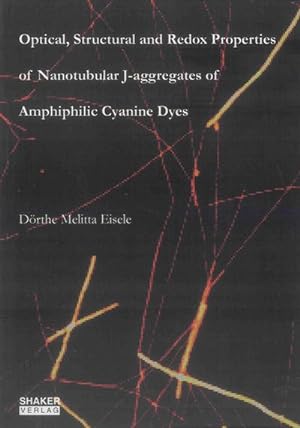eisele dorthe (1 résultats)
Type d'article
- Tous les types d'articles
- Livres (1)
- Magazines & Périodiques
- Bandes dessinées
- Partitions de musique
- Art, Affiches et Gravures
- Photographies
- Cartes
-
Manuscrits &
Papiers anciens
Etat
- Tous
- Neuf
- Ancien ou d'occasion
Reliure
- Toutes
- Couverture rigide
- Couverture souple
Particularités
- Edition originale
- Signé
- Jaquette
- Avec images
- Sans impression à la demande
Pays
Evaluation du vendeur
-
Optical, Structural and Redox Properties of Nanotubular J-aggregates of Amphiphilic Cyanine Dyes (Berichte aus der Physik)
Edité par Shaker Verlag, 2010
ISBN 10 : 3832291202ISBN 13 : 9783832291204
Vendeur : AHA-BUCH, Einbeck, Allemagne
Livre
Taschenbuch. Etat : Gebraucht. Gebraucht - Sehr gut SG - leichte Beschädigungen oder Verschmutzungen, ungelesenes Mängelexemplar, gestempelt, Versand Büchersendung - This work addresses fundamental questions in the field of supramolecular nanoscale systems of self-assembled pi-conjugated molecules by presenting a comprehensive investigation of one particular supramolecular system: the double-walled nanotubular J-aggregates of amphiphilic cyanine dye 3,3' -bis(2-sulfopropyl)-5,5',6,6'-tetrachloro-1,1'-dioctylbenzimidacarbocyanine (C8S3). (i) It is shown that single tubular J-aggregates and bundles composed of several tubes can be distinguished by their unique optical spectra. The effects of the aggregation time, dye concentration, pH value, and surface treatment on the formation of bundled tubes were determined. Using this information, the controlled preparation of aggregate solutions containing mainly single tubular J-aggregates was possible. (ii) The drop-flow technique was developed to isolate individual tubular C8S3 J-aggregates by deposition from solution onto solid substrates without damaging their delicate supramolecular structure. Polarization resolved near-field scanning optical microscopy of individual tubular J-aggregates exhibits that they have a remarkably uniform structure along the individual tube, as well as among different tubes within the ensemble. Moreover, the linear reduced emission dichroism of the single tubular J-aggregates was determined to D0 =0.71 ± 0.05, which fundamentally impacts for future theoretical calculations of the excitonic transitions of such double-walled cylindrical aggregate systems. These findings make this C8S3 J-aggregates excellent model systems for the investigation of exciton transport in individual quasi-one-dimensional nanostructures as well as for light harvesting. (iii) Spectro-electrochemical studies of C8S3 J-aggregates immobilized on an indium tin oxide (ITO) and on new graphene-based optical transparent (G-OTEs) electrodes reveal excellent correlation of J-aggregate redox potentials with the optical response, which allows to associate the observed optical phenomena with electron-transfer processes. An overall electrochemical-chemical-electrochemical (ECE) mechanism is determined, in which the oxidation of the J-aggregate is attributed to dimerization processes of its p-conjugated systems.


